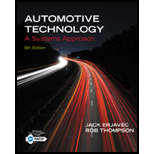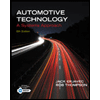
Automotive Technology: A Systems Approach (MindTap Course List)
6th Edition
ISBN: 9781133612315
Author: Jack Erjavec, Rob Thompson
Publisher: Cengage Learning
expand_more
expand_more
format_list_bulleted
Concept explainers
Textbook Question
Chapter 38, Problem 7ASRQ
While discussing the power flow through a five-speed transmission while it is in first gear: Technician A says that power enters on the input shaft, which rotates the countershaft that is engaged with first gear. Technician B says that the first gear synchronizer engages with the clutching teeth of first gear and locks the gear to the main shaft, allowing power to flow from the input gear through the countershaft and to first gear and the main shaft. Who is correct?
a. Technician A only
b. Technician B only
c. Both A and B
d. Neither A nor B
Expert Solution & Answer
Want to see the full answer?
Check out a sample textbook solution
Students have asked these similar questions
When discussing the various gear positions of a transfer case, Technician A says that when the transfer case is in low, the overall gear ratio is numerically increased. Technician B says that when the transfer case is in the high position, the vehicle operates in an overdrive mode due to the decrease in torque multiplication. Who is correct?
Explanation Need.
WHEN A TRANSMISSION IS IN OVERDRIVE:
A. THE OUTPUT SHAFT TURNS FASTER THAN THE ENGINE. (POSSIBLE CORRECT AWNSER)
B. THE INPUT AND OUTPUT SHAFTS BOTH TURN FASTER THAN THE ENGINE SPEED. (NOT CORRECT AWNSER)
C. THE REAR WHEELS TURN FASTER THAN THE ENGINE.
D. THE OUTPUT SHAFT TURNS SLOWER THAN THE INPUT SHAFT.
Explain the operation principle of a differential system and how a differential system relates to epicyclic gear trains
Chapter 38 Solutions
Automotive Technology: A Systems Approach (MindTap Course List)
Ch. 38 - What determines whether a conventional...Ch. 38 - Name the three drive configurations that a gearset...Ch. 38 - True or False? A reverse idler gear changes the...Ch. 38 - Define the purpose of the final drive gears.Ch. 38 - Explain the role of shift rails and shift forks in...Ch. 38 - True or False? In most transmissions and...Ch. 38 - The number of gear teeth per unit of measurement...Ch. 38 - Which of the following gear ratios indicates an...Ch. 38 - Which type of gear develops gear whine at high...Ch. 38 - When an idler gear is placed between the driving...
Ch. 38 - The component used to ensure that the mainshaft...Ch. 38 - In a transaxle, the pinion gear on the pinion...Ch. 38 - True or False? The cone on a synchronizers...Ch. 38 - Which of the following gear ratios provides the...Ch. 38 - What does a shift blocking system do, and how does...Ch. 38 - Technician A says that most transaxles have a...Ch. 38 - While discussing the various types of...Ch. 38 - Technician A says that the countergear or cluster...Ch. 38 - Technician A says that reverse lamp switches are...Ch. 38 - Technician A says that if a single idler gear is...Ch. 38 - Technician A says that in a conventional...Ch. 38 - While discussing the power flow through a...Ch. 38 - Prob. 8ASRQCh. 38 - Prob. 9ASRQCh. 38 - While discussing shift mechanisms: Technician A...
Knowledge Booster
Learn more about
Need a deep-dive on the concept behind this application? Look no further. Learn more about this topic, mechanical-engineering and related others by exploring similar questions and additional content below.Similar questions
- Technician A says that in a conventional transmission, the speed gears freewheel around the mainshaft until they are locked to it by the appropriate synchronizer. Technician B says that speed gears are an integral part of the countershaft assembly. Who is correct? a. Technician A only b. Technician B only c. Both A and B d. Neither A nor Barrow_forwardTechnician A says that when a car is moving straight ahead, all differential gears rotate as a unit. Technician B says that when a car is turning a corner, the inside differential side gear rotates slowly on the pinion, causing the outside side gear to rotate faster. Who is correct? a. Technician A only b. Technician B only c. Both A and B d. Neither A nor Barrow_forwardWhen a transmission is described as having two planetary gearsets in tandem, what does this mean?arrow_forward
- While discussing a Lepelletier system: Technician A says that two simple planetary gearsets are connected in tandem. Technician B says that these systems rely on various combinations of the planetary gears to obtain many forward gears. Who is correct? a. Technician A only b. Technician B only c. Both A and B d. Neither A nor Barrow_forwardTechnician A says that if the shift for all forward gears is delayed, a slipping forward clutch is normally indicated. Technician B says that a bad forward clutch is indicated when there is a slip when the transmission shifts into any forward gear. Who is correct? a. Technician A only b. Technician B only c. Both A and B d. Neither A nor Barrow_forwardA rough, growling noise occurs when a vehicle with a manual transmission is moving in any gear: Technician A says that the rear input shaft bearing may be at fault. Technician B says that this condition indicates the countergear bearings may be faulty. Who is correct? a. Technician A only b. Technician B only C. Both A and B d. Neither A nor Barrow_forward
- The component used to ensure that the mainshaft (output shaft) and main (speed) gear locked to it are rotating at the same speed is known as a_____. a. synchronizer b. shift detent c. shift fork d. transfer casearrow_forwardTo achieve a slow overdrive in a simple planetary gearset, the . a.sun gear must be the input member b.ring gear must be the input member c.planetary cart"ier must be the input memberring gear must be held d. ring gear must be heldarrow_forwardWhile discussing shift mechanisms: Technician A says that the interlock notches hold the transmission in the selected gear. Technician B says that the detent notches prevent the selection of more than one gear during operation. Who is correct? a. Technician A only b. Technician B only c. Both A and B d. Neither A nor Barrow_forward
- Technician A says that the countergear or cluster gear is actually several gears machined out of single piece of iron or steel. Technician B says that the countergear is driven by the clutch gear and drives the mainshaft speed gears. Who is correct? a. Technician A only b. Technician B only c. Both A and B d. Neither A nor Barrow_forwardA rough, growling noise that is heard from a transaxle while it is in neutral with the engine running, the vehicle stationary, and the clutch engaged is a likely indication that there is a problem in the a. transaxie input shaft bearings b. transaxie main (intermediate) shaft bearings c. first/second synchronizer assembly d. pinion and ring gear interactionarrow_forwardExplain the role of shift rails and shift forks in the operation of a transmission or transaxle.arrow_forward
arrow_back_ios
SEE MORE QUESTIONS
arrow_forward_ios
Recommended textbooks for you
 Automotive Technology: A Systems Approach (MindTa...Mechanical EngineeringISBN:9781133612315Author:Jack Erjavec, Rob ThompsonPublisher:Cengage Learning
Automotive Technology: A Systems Approach (MindTa...Mechanical EngineeringISBN:9781133612315Author:Jack Erjavec, Rob ThompsonPublisher:Cengage Learning

Automotive Technology: A Systems Approach (MindTa...
Mechanical Engineering
ISBN:9781133612315
Author:Jack Erjavec, Rob Thompson
Publisher:Cengage Learning
Power Transmission; Author: Terry Brown Mechanical Engineering;https://www.youtube.com/watch?v=YVm4LNVp1vA;License: Standard Youtube License